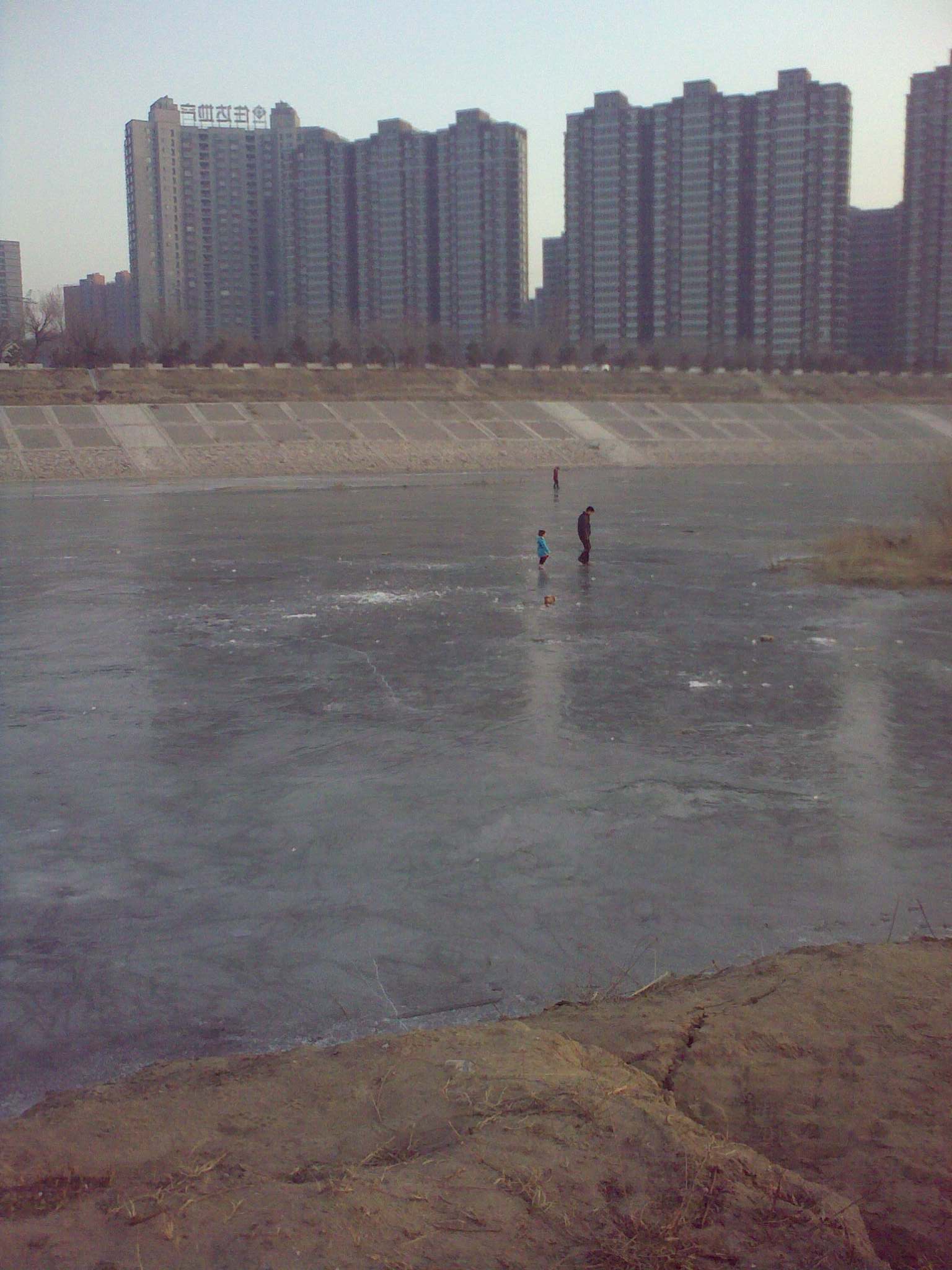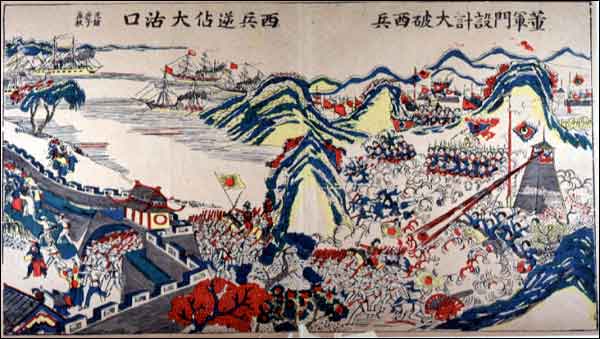|
Hai River
The Hai River (海河, lit. "Sea River"), also known as the Peiho, ("White River"), or Hai Ho, is a Chinese river connecting Beijing to Tianjin and the Bohai Sea. The Hai River at Tianjin is formed by the confluence of five watercourses: the Southern Canal, Ziya River, Daqing River, Yongding River, and the Northern Canal. The southern and northern canals are parts of the Grand Canal. The Southern Canal is joined by the Wei River at Linqing. The Northern Canal joins with the Bai He (or Chaobai River) at Tongzhou. The Northern Canal (sharing a channel with Bai He) is also the only waterway from the sea to Beijing. Therefore, early Westerners also called the Hai He the Bai He. At Tianjin, through the Grand Canal, the Hai connects with the Yellow and Yangtze rivers. The construction of the Grand Canal greatly altered the rivers of the Hai He basin. Previously, the Wei, Ziya Yongding and Bai Rivers flowed separately to the sea. The Grand Canal cut through the lower reaches o ... [...More Info...] [...Related Items...] OR: [Wikipedia] [Google] [Baidu] |
Tianjin
Tianjin (; ; Mandarin: ), alternately romanized as Tientsin (), is a municipality and a coastal metropolis in Northern China on the shore of the Bohai Sea. It is one of the nine national central cities in Mainland China, with a total population of 13,866,009 inhabitants during the 2020 Chinese census. Its built-up (''or metro'') area, made up of 12 central districts (all but Baodi, Jizhou, Jinghai and Ninghe), was home to 11,165,706 inhabitants and is also the world's 29th-largest agglomeration (between Chengdu and Rio de Janeiro) and 11th- most populous city proper. It is governed as one of the four municipalities under the direct administration of Chinese central government and is thus under direct administration of the State Council. Tianjin borders Hebei Province and Beijing Municipality, bounded to the east by the Bohai Gulf portion of the Yellow Sea. Part of the Bohai Economic Rim, it is the largest coastal city in Northern China and part of the Jing-Jin-Ji meg ... [...More Info...] [...Related Items...] OR: [Wikipedia] [Google] [Baidu] |
Chaobai River
The Chaobai River () is a river in northern China. The river is 458 km long and flows from the confluence of the Chao and Bai Rivers at the Miyun Reservoir in Beijing Municipality through Hebei Province and into the Grand Canal of the Hai River The Hai River (海河, lit. "Sea River"), also known as the Peiho, ("White River"), or Hai Ho, is a Chinese river connecting Beijing to Tianjin and the Bohai Sea. The Hai River at Tianjin is formed by the confluence of five watercourses: the ... system in Tianjin Municipality. Its average depth is 2.5 meters. References Rivers of Beijing {{China-river-stub ... [...More Info...] [...Related Items...] OR: [Wikipedia] [Google] [Baidu] |
United States Government Printing Office
The United States Government Publishing Office (USGPO or GPO; formerly the United States Government Printing Office) is an agency of the legislative branch of the United States Federal government. The office produces and distributes information products and services for all three branches of the Federal Government, including U.S. passports for the Department of State as well as the official publications of the Supreme Court, the Congress, the Executive Office of the President, executive departments, and independent agencies. An act of Congress changed the office's name to its current form in 2014. History The Government Printing Office was created by congressional joint resolution () on June 23, 1860. It began operations March 4, 1861, with 350 employees and reached a peak employment of 8,500 in 1972. The agency began transformation to computer technology in the 1980s; along with the gradual replacement of paper with electronic document distribution, this has led to a ... [...More Info...] [...Related Items...] OR: [Wikipedia] [Google] [Baidu] |
Eight-Nation Alliance
The Eight-Nation Alliance was a multinational military coalition that invaded northern China in 1900 with the stated aim of relieving the foreign legations in Beijing, then besieged by the popular Boxer militia, who were determined to remove foreign imperialism in China. The Allied forces consisted of about 45,000 troops from what have, in popular tradition, been called eight 'nations' but included several empires, so thus actually far more than 8 nations in our contemporary 21st century terms, comprising: the German Empire, the Empire of Japan, the Russian Empire, the British Empire, particularly including forces from its full and sub-continent domains of Australia which was not a discrete official alliance signatory and the Empire of India, France which continued with overseas possessions, the United States which as democracy has historically demurred its global reach as 'empire', Italy, a kingdom in this peirod, and the Empire of Austria-Hungary. Neither the Chinese nor the ... [...More Info...] [...Related Items...] OR: [Wikipedia] [Google] [Baidu] |
Battle Of Taku Forts (1900)
The Battle of the Taku or Dagu Forts was a short engagement during the Boxer Rebellion between the Chinese Qing dynasty military and forces belonging to Eight Nation Alliance in June 1900. European and Japanese naval forces captured the Taku forts after a brief but bloody battle with units of the Qing dynasty. Their loss prompted the Qing government to side with the Boxers while the Chinese army was ordered to resist all foreign military forces within Chinese territory. Allied powers remained in control of the forts until the end of the Boxer Rebellion in September 1901. Background In mid-June 1900, allied forces in northern China were vastly outnumbered. In Beijing there were 450 soldiers and marines from eight countries protecting the diplomatic legations. Somewhere between Tianjin and Beijing were the 2,000 men in the Seymour Expedition attempting to get to Beijing to reinforce the legation guards. In Tianjin were 2,400 Allied soldiers, mostly Russians. All of thes ... [...More Info...] [...Related Items...] OR: [Wikipedia] [Google] [Baidu] |
Naval Mine
A naval mine is a self-contained explosive device placed in water to damage or destroy surface ships or submarines. Unlike depth charges, mines are deposited and left to wait until they are triggered by the approach of, or contact with, any vessel or a particular vessel type, akin to anti-infantry vs. anti-vehicle mines. Naval mines can be used offensively, to hamper enemy shipping movements or lock vessels into a harbour; or defensively, to protect friendly vessels and create "safe" zones. Mines allow the minelaying force commander to concentrate warships or defensive assets in mine-free areas giving the adversary three choices: undertake an expensive and time-consuming minesweeping effort, accept the casualties of challenging the minefield, or use the unmined waters where the greatest concentration of enemy firepower will be encountered. Although international law requires signatory nations to declare mined areas, precise locations remain secret; and non-complying indivi ... [...More Info...] [...Related Items...] OR: [Wikipedia] [Google] [Baidu] |
Boxer Rebellion
The Boxer Rebellion, also known as the Boxer Uprising, the Boxer Insurrection, or the Yihetuan Movement, was an Xenophobia, anti-foreign, anti-colonialism, anti-colonial, and Persecution of Christians#China, anti-Christian uprising in China between 1899 and 1901, towards the end of the Qing dynasty, by the Boxers (group), Society of Righteous and Harmonious Fists (), known as the "Boxers" in English because many of its members had practised Chinese martial arts, which at the time were referred to as "Chinese boxing". After the First Sino-Japanese War, Sino-Japanese War of 1895, villagers in North China feared the expansion of Spheres of influence#China, foreign spheres of influence and resented the extension of privileges to Christian missionaries, who used them to shield their followers. In 1898 Northern China experienced several natural disasters, including the Yellow River flooding and droughts, which Boxers blamed on foreign and Christian influence. Beginning in 1899, Box ... [...More Info...] [...Related Items...] OR: [Wikipedia] [Google] [Baidu] |
Taku Forts
The Taku Forts or Dagu Forts, also called the Peiho Forts are forts located by the Hai River (Peiho River) estuary in the Binhai New Area, Tianjin, in northeastern China. They are located southeast of the Tianjin urban center. History The first fort was built during the reign of the Ming Jiajing Emperor between 1522 and 1527. Its purpose was to protect Tianjin from attack by wokou sea raiders. Later, in 1816, the Qing government built the first two forts on both sides of the Haihe estuary in response to increased concerns about seaborne threats from the West. By 1841, in response to the First Opium War, the defensive system in Dagukou was reinforced into a system of five big forts, 13 earthen batteries, and 13 earthworks. In 1851, Imperial Commissioner Sengge Rinchen carried out a comprehensive renovation of the forts, building 6 large forts: two on the south of the estuary, called "Wēi" (威-Might) and "Zhèn"(震-Thunder, Tremor, Quake), three to the north, "Hǎi"(海-s ... [...More Info...] [...Related Items...] OR: [Wikipedia] [Google] [Baidu] |
Second Opium War
The Second Opium War (), also known as the Second Anglo-Sino War, the Second China War, the Arrow War, or the Anglo-French expedition to China, was a colonial war lasting from 1856 to 1860, which pitted the British Empire#Britain's imperial century (1815–1914), British Empire and the Second French Empire, French Empire against the Qing dynasty of China. It was the second major conflict in the Opium Wars, which were fought over the right to import opium to China, and resulted in a second defeat for the Qing dynasty and the forced legalisation of the opium trade. It caused many Chinese officials to believe that conflicts with the Western powers were no longer traditional wars, but part of a looming national crisis. In 1860, British and French troops landed near Beijing and fought their way into the city. Peace negotiations quickly broke down and the British High Commissioner to China ordered the foreign troops to loot and destroy the Old Summer Palace, Imperial Summer Palace ... [...More Info...] [...Related Items...] OR: [Wikipedia] [Google] [Baidu] |
Battle Of Taku Forts (1858)
The First Battle of Taku Forts () was the first attack of the Anglo-French alliance against the Taku Forts along the Hai River in Tianjin, China, on 20 May 1858, during the Second Opium War. The British and French sent a squadron of gunboats, under Rear-Admiral Admiral Michael Seymour, to attack China's Taku Forts. The battle ended as an allied success. However, the first phase of the Second Opium War would end with the Treaties of Tianjin and the forts were returned to the hands of the Qing Army, leading to the Second Battle of Taku Forts in 1859. Background After the outbreak of the Second Opium War, the Anglo-French alliance captured the significant harbor of Canton (Guangzhou) during the Battle of Canton in 1857. The Xianfeng Emperor received the news that Canton had been occupied on 27 January 1858. The British commander Michael Seymour, hoping to force a settlement (the later Treaty of Tianjin), ordered an attack on the Taku Forts as they were the closer path ... [...More Info...] [...Related Items...] OR: [Wikipedia] [Google] [Baidu] |
Tianjin Hai River 2
Tianjin (; ; Mandarin: ), alternately romanized as Tientsin (), is a municipality and a coastal metropolis in Northern China on the shore of the Bohai Sea. It is one of the nine national central cities in Mainland China, with a total population of 13,866,009 inhabitants during the 2020 Chinese census. Its built-up (''or metro'') area, made up of 12 central districts (all but Baodi, Jizhou, Jinghai and Ninghe), was home to 11,165,706 inhabitants and is also the world's 29th-largest agglomeration (between Chengdu and Rio de Janeiro) and 11th- most populous city proper. It is governed as one of the four municipalities under the direct administration of Chinese central government and is thus under direct administration of the State Council. Tianjin borders Hebei Province and Beijing Municipality, bounded to the east by the Bohai Gulf portion of the Yellow Sea. Part of the Bohai Economic Rim, it is the largest coastal city in Northern China and part of the Jing-Jin-Ji megapolis ... [...More Info...] [...Related Items...] OR: [Wikipedia] [Google] [Baidu] |
Yongding River
The Yongding River () is a river in northern China. It is one of the main tributaries in the Hai River system and is best known as the largest river to flow through Beijing. In recent years, the Beijing segment of the river has dried up due to environmental issues. The Beijing municipal government has invested 16 billion yuan in an effort to replace the riverbed with parkland or smaller bodies of water. Etymology The river was originally called Wuding River (), literally "unfixed river", because its flow was irregular. When the Kangxi Emperor reigned, he enacted various hydraulic engineering projects in the region to rein in the seasonal flooding. After those projects, the river was renamed to its modern name, which means "ever-fixed river". Geography The Yongding River is in length and drains an area of . It emerges from the Guancen Mountains (管涔山) in Ningwu County, Shanxi Province, where it is known as the Sanggan River (桑干河) and flows northeast into Inner Mongo ... [...More Info...] [...Related Items...] OR: [Wikipedia] [Google] [Baidu] |









